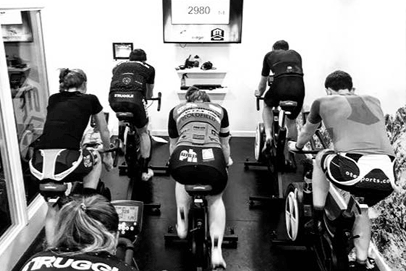Zwift racing? Steady three hours (Netflix and chill)? Whatever indoor training you're doing to keep safe and sane over the icy months, make your turbo training count this winter by adding in quality top-end turbo sessions to boost your fitness leading up to the Struggle sportives.
Benefits of High-intensity Turbo Training?
Here at Struggle HQ we're advocates of getting the most training bang for our buck. HIIT (high intensity interval training) provides time-shy cyclists an anaerobic workout that increases cardiovascular capacity and is said to bring about physical adaptations in a shorter amount of time.
High-intensity turbo training on dark week nights, coupled with long steady-state training at the weekend (polarised training) is how we roll! It's the most time-effective approach for all cyclists - be it sportive riders or bike racer - to fit training around work and family life.
Why Train in an Altitude Chamber?
To add insult to injury, we head to the OTE Performance Centre in Leeds where instructor Ashley Marshal puts us in the pain locker with some intensive sprint sets performed under oxygen deficit in their OTE Altitude Chamber simulating 3,000m above sea level.
Hypoxic training in an altitude chamber is said to improve the body's ability to perform better with restricted oxygen (for example, when climbing one of the super-steep Yorkshire ascents on the Struggle).
It is also said that riders undergoing hypoxic training gain from slower fatigue, improved recovery, increased time effectivity and much more. Visit OTE Performance Centre to read more. Quote Struggle90 for £20 off a block of training in the chamber.
Try this Turbo Session at Home:
Top Tip: Don't go too hard at the start of each set. Moderate your effort to ensure you can hold the same power/cadence for each effort of each set. Ensure you take advantage of the recovery by taking deep exhalations to expel the CO2, keep spinning during the recovery to expel the lactic acid quicker and keep drinking.
Warm Up:
- 4 min steady state
- 1 min increasing tempo
- 1 min off
- 1 min increasing tempo (1 resistance higher)
- 2 min off
SET 1: Progressive Sprints
- 15 second hard, 5 second sprint (moderate resistance)
- 50 second recovery
- Repeat 5 times
SET 2: High-Intensity Sprints
- 7 second sprints (high resistance)
- 45 second recovery
- Repeat 6 times
SET 3: Pre-TT effort Sprints
- 10 sec seated sprint, 35 sec TT (pick cadence/power and try to hold it)
- 1 min 20 recovery
- Repeat 4 times
SET 4: Pyramid Sprint Set
- 5 sec sprint
- 20 second recovery
- 7 sec sprint
- 30 second recovery
- 10 sec sprint
- 40 sec recovery
- 10 sec sprint
- 30 second recovery
- 7 sec sprint
- 20 second recovery
- 5 sec sprint
SET 5: Final Effort
- 2 min effort
- Every 30 second lift the pace
- At 1 minute, try and take the bike up 1 notch on resistance
- Last 30 second should be very hard
- 2 min recovery
- Repeat
Cool Down
